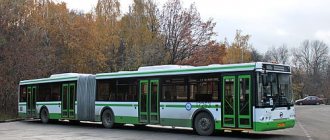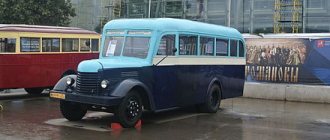Those who were born in the USSR in the 50-70s of the last century remember very well the long yellow Hungarian buses of the Ikarus brand, which, bending bizarrely, overcame sharp turns, since they constantly traveled on them, paying 5 kopecks for travel (some I also traveled for free - as a “hare”).
This is how the division of labor worked within the world system of socialism. Hungary supplied Ikarus buses to all countries that are members of the CMEA (Council for Mutual Economic Assistance), as well as to many African countries and individual European countries (Sweden, West Germany, Finland and a number of others). It is interesting that, as a rule, buses of the same model were delivered to different countries in different “colors”. Later, when the Ikarus brand (more correctly pronounced “Ikarush” with the accent on the first syllable) became known throughout the world, joint ventures were organized in the developed industrial countries of North America, as well as in Cuba, North Korea and Indonesia.
History of the brand
And it all began at the very end of the century before last with a small workshop in Budapest (Austria-Hungary), which was founded by Imre Uri. After 30 years, this company began producing bus bodies, and under his sons, 1,000 buses were assembled in 1939.
After the end of World War II, the company was nationalized and, merging with JSC Ikarus, retained the name of the latter. This company began its path to world fame in 1962 after the transfer of the plant in Székesfehérvár to it. This plant was specially built for the production of Ikarus buses of the 200th model. The overwhelming majority of city and intercity buses were supplied to the Soviet Union. With its collapse, the company, naturally, having lost its sales markets, curtailed almost all of its production and was divided into two - according to the number of factories (Budapest and Székesfehérvár), which carried out individual orders.
In the penultimate year of the last century, the Ikarusbus group tried to breathe “life” into them, but failed. In 2007, the EAG company (plant in Budapest) was officially declared bankrupt, and in Szekesfehérvár, surviving “from bread to kvass”, exists today in conditions of fierce competition within the European Union.
Basic information, characteristics
- Manufacturer/manufacturer where the equipment is produced/manufactured. karus (Ikarus) is a Hungarian bus manufacturing company specializing in the production of city, intercity and special buses. Founded in 1895 as a blacksmith and carriage workshop in Budapest. In the 1980s, it reached an annual production volume of up to 12 thousand cars per year, which placed Ikarus among the largest bus manufacturers in Europe. Currently a small private company.
- Purpose. Urban, suburban.
- Class. Big.
- Body type. Frameless truss welded.
"Ikarus" up to 250 model
In 1953, production of intercity buses model 55 with a carriage-type body began, and a year later the Ikarus-Lux.
These were very comfortable buses for those years and were produced (with minor improvements) for two decades. Drivers called the Ikarus-Lux a “vacuum cleaner” for its futuristic (cigar-like profile, square face), headlight above the windshield and noisy engine. 11 meters long, it had a six-cylinder diesel engine with 170 hp, which was located at the rear. This ensured that there was no corresponding smell in the cabin, which was common when subsequent models of this brand were used in Russia. Thirty-two soft seats, a suspension with hydraulic shock absorbers and a top speed of 98 km/h provided comfortable travel conditions. These buses were very reliable and lasted up to a million kilometers without major repairs.
In 1966, the production of the super-capacity, more than 16 meters long (there were countless people jammed there) city bus “Ikarus” model 180 began, which lasted seven years. It was white with a red stripe, with a carriage-type body that had four passenger doors and an accordion vestibule, as well as body regulators powered by compressed air. The engine is also a six-cylinder diesel, 192-horsepower Raba-MAN. The maximum speed (63 km/h) in urban conditions was almost impossible to achieve. There was little comfort in this model, for which in the USSR it was nicknamed “cattle carrier”, and for its appearance it was also called “accordion”. This model was replaced in the 70s of the 20th century by the Ikarus-280.
Magnificent "wanderer" - "Ikarus-256"
The Ikarus-256 model was produced for half a century, which first came off the assembly line in 1977. It was a slightly improved Ikarus-250 - more comfortable and a meter shorter (length 11 meters). The capacity of the Ikarus bus was designed to transport tourists, including foreign ones, and it had 45 soft seats. The last five seats are combined into a “sleeping” sofa, which is slightly raised (two steps) above the rest of the bus interior. An undoubted innovation for that time was the presence of a TV mounted to the right of the driver. In contrast to all this splendor were the luggage racks that this model inherited from the Ikarus-255 (fabric mesh on the frame).
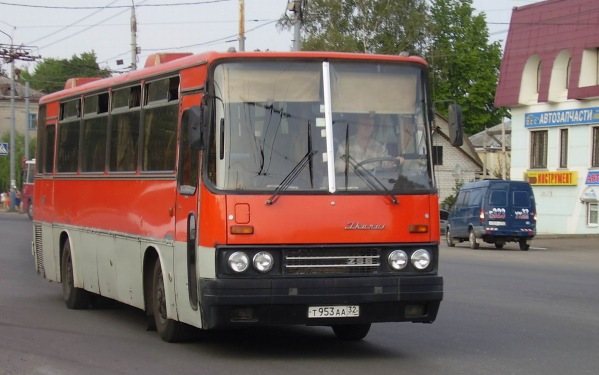
The design remained unchanged. The body is monocoque, carriage type, the engine is rear-mounted and more powerful than on previous models (250 l/s). The luggage compartment has become significantly larger. The location of the company logo and the number 256 is above the air intake. There was a panoramic, two-part, huge windshield, rear-view mirrors of the “hare ears” type and powerful two pairs of headlights with lens coating.
Model 260
For a third of a century, until the second year of our century, the production of the Ikarus-260 bus continued. Interestingly, this model had 30 modifications (versions were even produced for mountainous regions). Unlike other buses of this company, the color of the Ikarus delivered to the USSR was yellow.
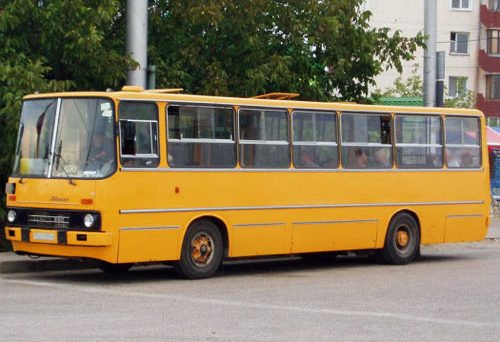
Also, for the first time, air suspension was used, which was previously mechanical and “burned out” after a year of driving. The body is standard, with three passenger doors (four folding doors). The engine is located under the floor, the cabin is heated both from the engine cooling system and by air. Capacity up to 107 people, seating – 22. At full capacity, the weight of the bus could exceed 15 tons. The maximum speed of 66 km/h was not allowed within populated areas.
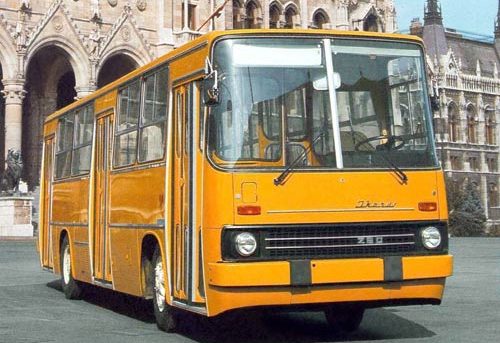
Specifications
Are common
- Body type - monocoque
- Number of seats (“Lux”) – 32 (34)
- Number of doors (“Lux”) – 2 + driver’s (1 + driver’s)
- Fuel capacity, l - 250
- Weight, kg:
dry — 9,300 equipped — 9,500 full — 12,730
- Total weight distribution, kg:
on the front axle - 4,250 on the rear axle - 8,480
- Turning radius along the front outer wheel track, m - 10.25
- Maximum speed with full load, km/h - 98
- Maximum climbability, % - 27
- Control fuel consumption, l/100 km - 32
- Trunk capacity, m³ – 4.8
- Dimensions, mm:
length - 11,400 width - 2,500 height - 2,870
- Wheelbase, mm - 5,550
- Ground clearance, mm - 290
- Overhangs, mm:
front - 2,300 rear - 3,385 [ source not specified 76 days
]
Engine
- Location - rear
- Model - “Csepel D-614”
- Type - four-stroke, diesel, pre-chamber
- Number of cylinders - 6
- Number of crankshaft supports - 7
- Cylinder arrangement - in-line
- Valve location - top
- Cylinder diameter, mm - 112
- Piston stroke, mm - 140
- Cylinder displacement, l — 8.28
- Compression ratio - 19
- The operating order of the cylinders is 1-5-3-6-2-4
- Maximum power (“Lux”), l. With. — 145 (170) at 2300 rpm
- Maximum torque, kg m - 50 at 1400 rpm
- Minimum specific fuel consumption, g/l. s.ch - 190
- Cooling system - liquid
- Lubrication system - combined
- Dry engine weight, kg - 630 [ source not specified 76 days
]
Transmission
- Clutch - single disc, dry
- Gearbox - mechanical, five-speed, three-way, with synchronizers for 2nd-5th gears
- Gearbox ratios - I-6.17; II-2.99; III-1.59; IV-1.00; V-0.78; Z.H.-6.68
- The main gear of the rear axle is two-stage, gear ratio is 5.85
- Gearboxes:
central - bevel, gear ratio - 1.78 wheel - planetary, gear ratio - 3.28 [ source not specified 76 days
]
Steering
- Steering mechanism - globoidal worm and double roller, gear ratio - 29
- Amplifier - hydraulic [ source not specified 76 days
]
Brake systems
- Working - drum type, on all wheels, with pneumatic drive
- Parking - drum type, on rear wheels, with mechanical drive
- Retarder - motor, valve type, closing the engine exhaust pipe and fuel supply, pneumatically controlled [ source not specified 76 days
]
Modular design
The Ikarus-280 bus replaced the Ikarus-180, which had already exhausted its service life. The main idea of this model was its modular design, so it had more than fifty modifications. It was possible to change everything in it - from the length of the bus itself (maximum 18 meters), the number of doors (from one to four) to almost any brand of engine and type of transmission.

In outline it was already a regular parallelepiped with a rounded frontal view. The engine produced 190 l/s, was located under the floor, and had a service life of half a million kilometers before major repairs. Large areas accommodated more than one and a half hundred passengers, with 35 seats. The floor was covered with a rubber carpet. Smooth running (a distinctive feature of the Ikarus-280) was achieved by a large number of air cylinders. The drum brakes are equipped with a pneumatic drive.
What technical characteristics does the Ikarus bus have:
What does the Ikarus bus look like? The reader can see his photo in our article.
Delivery of Ikarus to the USSR and post-Soviet space
As mentioned above, almost all Ikaruses were sent for operation in the USSR. Firstly, to pay off oil and gas supplies, and secondly, it was taken into account that in the 70s of the last century its population exceeded a quarter of a billion people. The peak of deliveries occurred at the end of the 80s of the 20th century, and in total in the second half of this century (including deliveries to the renewed Russia), more than 140 thousand copies of various models and modifications arrived to us. In addition, in the “dashing” nineties, the Ikarus bus was assembled in Moscow, Kurgan and Arzamas. The last batch was delivered to the Republic of Tajikistan in 2002.
"Ikarus" - an accordion, especially under operating conditions in the USSR, had the following negative effect. Some of the equipment was located under the floor of the passenger compartment, and after frequent repairs, which were carried out by Soviet rather than careful Western specialists, the seals no longer prevented the penetration of soot and exhaust gases into the cabin, for which the buses began to be popularly called “gas chambers.”
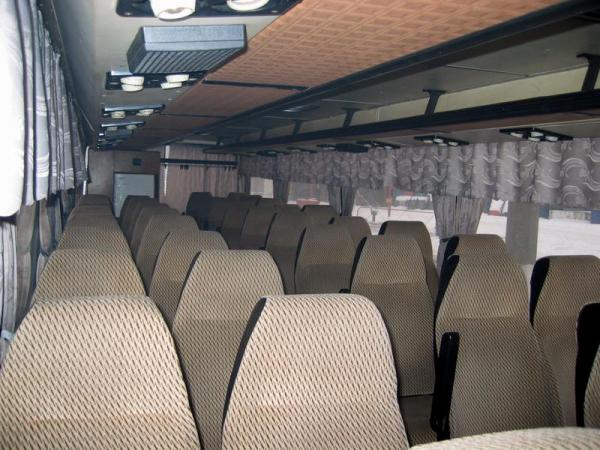
This year marks the half-century anniversary of the start of deliveries of the Ikarus-256 bus to Moscow. Mosgortrans has a bus of this model that is still working. He is registered in Novokosino, where the fourth park is located. He has already covered 700 thousand km. (seven stars on board) and continues to work smoothly. Another such specimen works in the working village of Sapozhok, Ryazan region.
Buses that have survived to this day
In Russia, two Ikarus-55 buses have been preserved to this day as museum exhibits. [ source not specified 76 days
]
- The first is located in Moscow at the Museum of Passenger Transport.
- The second Ikarus-55 was restored in 2015-2016 for the museum of the State Unitary Enterprise Passazhiravtotrans. The bus body, which retained most of the original parts, including the engine, was purchased in October 2014. The bus was parked in the Moscow region on the territory of one of the closed enterprises in the forest. As of October 2020, the exterior and interior of the bus were completely restored; the vehicle did not move independently. On April 26, 2020, this car arrived under its own power at the site of the State Unitary Enterprise “Passenger Avtotrans” in St. Petersburg, completely restored.
In 2020, another copy of this bus model was discovered in Belarus. [ source not specified 76 days
]
There are three buses of the Ikarus-55 “Lux”
are still on the move and participate in exhibitions. [
source not specified 76 days
]
In total, about 20 buses of this type have survived to this day in the world, out of approximately 7,500 produced. [ source not specified 76 days
]


